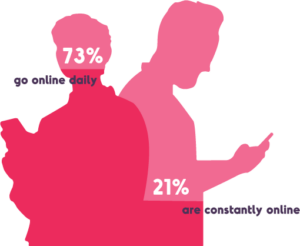
Tips for Non-Profit and Charity Website Design
Did you know that there are over 1.5 million registered nonprofit organizations in the United States? If you own a nonprofit or charity company, it’s essential to have a robust marketing strategy and web design. This approach increases your visibility online. It also helps people find your website. That translates to increased revenue and profit. We’re here to show you the very best charity website design ideas. Let’s get into it!
Why Your Website Is So Important
If you had any doubt at all, here’s the truth: you need a website. No ifs, ands, or buts about it. Your site is non-negotiable.
With more and more people turning online for information, this is the most crucial mode of advertising you have available to you. Don’t take that for granted.
In fact, recent studies show that 73% of Americans go online on a daily basis, and about 21% of people are “constantly online.” We’re hyper-connected, and it doesn’t seem to be a trend that’s slowing down anytime soon.

What does that mean for you and your company? It means that your website represents your company billboard, business card, and commercial rolled into one online platform. It means that your site must be fantastic.
Your website sets you apart from the competition. It allows people to find your company, learn about your mission statement, and ideally donate their time and money to your organization.
The right charity website design will keep people interested in your content. It will also keep them engaged and motivated to come back for more.
Getting Started
Don’t have a website yet? Not a problem. Well, it is a problem, but certainly not one that you can’t take care of today.
The good news? Starting a website is relatively easy and straightforward, and there is no shortage of free resources to help guide you.
In general, you do need to take care of the following housekeeping details:
- a hosting service provider
- a domain name
- a website platform
We’re going to explain each of these in a bit more detail below.
Your Hosting Service Provider
Hosting services provide the technology needed to store your website data. Think of it as the “launchpad” or “brainpower” of your website.
When people want to visit your website, they use your website address to get there. Their device connects that person to your server, and the browser delivers your web pages.
Most hosting companies require that you register a domain name with them. Popular hosting sites include BlueHost and GoDaddy, though there are numerous options available.
Your Domain Name
What’s in a name, they say?
Oh, just about everything. Your company and domain names are critical factors regarding how consumers perceive your organization.
Already have a name for your nonprofit or charity organization? Great! Check to see if it’s available from your hosting service provider. You’ll be able to find out right away.
Unavailable? Consider slight variations of your name- or consider changing the name altogether.
Keep the following tips in mind:
- Keep it short and simple
- Avoid hyphens or numbers
- Make it easy to type
- Use keywords
- Act quickly!
You want your name to be memorable and unique. Ask your colleagues for assistance in brainstorming ideas if needed.
Your Website Platform
There are numerous free and paid options for publishing and hosting your website. Many people use free blogging platforms like WordPress or Blogger. These platforms come with numerous options for design and style.
Your website platform provides the visual appearance of your content. Your template can essentially help you design any website style you want.
Many platforms come with customizable options that will allow you to change logos, color palettes, backgrounds, and add pages and posts.
Your Digital Marketing Strategy
Having a fantastic website is one thing (and an important thing at that). But, having people actually find and use your website is another.
Enter the importance of digital marketing for maximizing your charity website design.
All successful business owners understand the importance of efficient, dynamic marketing. They know the logistics of brand positioning and SEO optimization. They also know that marketing strategies continuously grow and evolve with changing times.
Whether you decide to DIY your marketing, hire an in-house specialist, or outsource to the professionals, this is not an area you want to skimp out on.
With nearly 50% of nonprofits set up to fail, proper planning and strategizing are essential to your success.
Starting the Charity Website Design Process
In the beginning stages, it’s essential to keep the conversation flowing. Consult with board members and colleagues about your desired demographic. Get brainstorming, and be patient with your website design process.
By narrowing down who you want to reach, you streamline your marketing strategies. You also create compelling, dynamic content that reaches the right people.
If your company doesn’t have an active mission statement, get one. Immediately. Determine what your cause is about and who are or what you are trying to help.
Figure Out Your Budget
Depending on your needs, a website can cost you a couple of dollars a month or tens of thousands of dollars per year.
Confused? Start small, but be realistic with your visions. Believe it or not, research suggests that nonprofits should invest more in advertising.
With that said, many reputable agencies offer customizable website plans that can tailor to your website’s specific needs. They do this while staying within the firm limits of a collaborated budget.
As a basic rule of thumb: the bigger the company, the more you’ll have to spend on your marketing budget.
Consult with your current board members, colleagues, and a local accountant if you are still in the preliminary stages of creating a budget.
Creating a Beautiful Charity Website Design: Popular Trends
Because your website is essential for establishing expertise and credibility in your industry, it’s imperative that you make a good impression.
You already know that technology continues to change. However, we’ve got a few current charity website design trending ideas that we think may be here to stay for awhile.
Videos
You know that feeling when you get lost in a funny dog video or prank? You just can’t stop watching, and it’s way more interesting than reading a long article? Yep. You’re not alone.
We like visual, dynamic media, and many companies are using this trend to their advantage.
You can use a professional background video as part of your charity website design. Or, you can simply get in the habit of posting compelling video content that will appeal to your demographic.
Does your charity focus on impoverished children? Perhaps you can make a video profiling why some of your donors choose to get involved. Maybe you can make a video showing a few children opening up their Christmas gifts.
Videos make for great call-to-action options. They are easily shareable across multiple platforms.
Infographics
If you’ve been on Pinterest lately, you’ve seen this trend everywhere. For your charity website design, infographics are both fun and interactive.
Many nonprofit organizations use statistics and research to raise awareness and reach out to their audience.
Rather than just writing these all out in a brochure or blog article, consider designing an infographic. Again, these are also easy to share and fun to read through. And, it’s a trend that only seems to be getting more and more popular.
Engaging Photos
Again, we’re in the age of visual, dynamic media. Most people don’t want to just scroll through a wall of text. They want to feel engaged with your content.
Consider using large, high-definition photos to complement your charity website design. You want your audience to feel the passion for your cause. You also want them to see it. What better way to do that then with dynamic photos?
After all, don’t they say a picture tells a thousand words? When it comes to your charity website design, we couldn’t agree more.
Gradients or Overlays
Even though the pure, white look has dominated websites, colors are making quite the comeback.
These overlays provide an excellent opportunity to post a vital picture with a significant and relevant quote.
Not only does this make dynamic and beautiful content, but it’s also easy to share and memorable for your audience.
Geometric Shapes
When it comes to your charity website design, minimalism still has a significant place in shaping the notion that less is more.
We expect to see themes of grids, angles, and blocks to continue dominating successful charity websites.
Other Design Trends
In addition to “visual” design, there are several technical trends to consider looking at when planning or auditing your charity website design.
Resource Hub or Directory
You already know that many people turn online for news and information. Expand on this and let your website shine as a leading expert in your industry.
Create a library or directory with relevant resources or articles. Help people locate additional support by providing numbers or email addresses.
And, make it accessible and easy to find! If people have to hunt for it in an obscure corner of your site, they won’t take the time or effort.
Be Active on Social Media
Are you on Facebook? Twitter? Instagram? If you’re not, are you under a proverbial rock? All jokes aside, your organization needs a social media presence.
For one, it’s a great way to increase your online visibility. As you increase your channels, people are more likely to find your organization.
Second, social media is a great way to interact with your audience, share content, and increase your advocacy efforts.
Best of all? Social media engagement doesn’t have to cost a lot of money or require a lot of time. It does, however, require discipline and motivation. You need to post statuses and share photos. You also need to acknowledge your followers and fans.
SEO Is, Was, and Will Be King of the Internet
Do you know what SEO means? If you have a basic understanding, congrats! The bad news? Having a basic understanding is not enough.
SEO, or Search Engine Optimization, is the process of increasing your visibility in search engines and is essential for launching your company and maximizing your charity website design.
Without it, even if you have the most fabulous organization in the world, you risk becoming another faceless brand in a sea of a million others. Don’t let that be you!
While SEO is something you can learn yourself, it does entail a steep learning curve. Chances are, you don’t have much spare time for that (because you’re probably running your organization).
Fortunately, many professionals are happy to help you from the comfort of their computers. Rather than spend your time researching long-tail keywords or inbound marketing, you can just focus on what you know best.
In many ways, it gives everyone the best of both worlds.
Final Thoughts
At Snowberry Media, we are passionate about creating cohesive, one-of-a-kind brands for all kinds of organizations.
Ready to level up your nonprofit or charity website design? Let’s chat today. We’d love to help make your digital dreams an actual reality.



